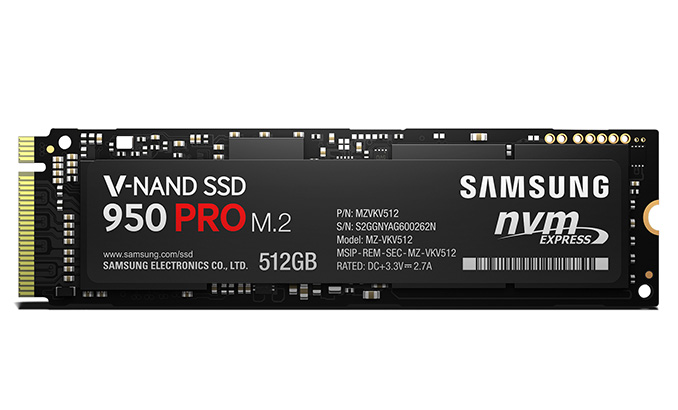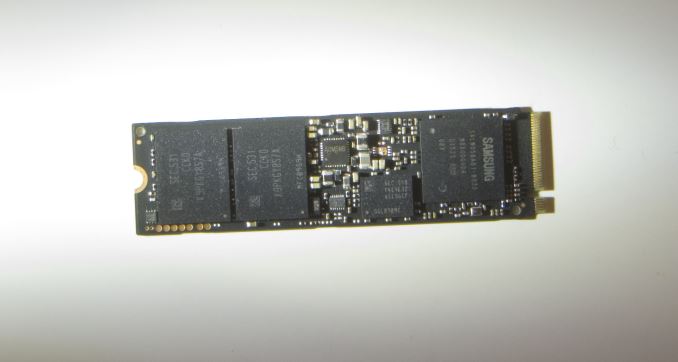The Samsung 950 Pro PCIe SSD Review (256GB and 512GB)
by Billy Tallis on October 22, 2015 10:55 AM EST
After shipping two generations of M.2 drives with PCIe interfaces for OEM customers, Samsung is releasing a PCIe drive to the retail market which has the added benefit of including the latest features Samsung offers. The Samsung 950 Pro is the new flagship consumer drive and it eschews the backwards compatibility and the 2.5" SATA form factor of the three previous iterations of the 8xx Pro family in favor of a PCI Express 3.0 x4 connection in the M.2 2280 form factor coupled with the NVMe protocol. Those changes allow for one of the biggest generational performance jumps in the history of the SSD industry and should help the transition of SSDs shedding the last vestiges and limited feature sets of their mechanical hard drive predecessors.
The M.2 2280 form factor has the potential to unify the consumer SSD market, with a physical size small enough for ultrabooks but a large enough capacity for all users. M.2, depending on the exact implementation used by the OEM, has the ability to provide SATA or high-performance PCIe connectivity, easing the transition. By supporting up to four lanes of PCIe 3.0, M.2 has helped make the two-lane SATA Express standard dead on arrival and ensures that drives won't be starving for bandwidth again for quite some time.
Meanwhile, high-end SSDs have been struggling to squeeze every last drop of performance out of the 6Gb/s SATA III interface. While some vendors have put out M.2 PCIe devices that support two lanes of PCIe, Samsung went straight for four lanes with the XP941 drive for OEMs to start. This was then upgraded to PCIe 3.0 speeds with the SM951. Earlier this year, they implemented the NVMe protocol which allows the SM951 to make use of the available bandwidth of the PCIe 3.0 x4 link. With Intel's Skylake platform bringing plentiful I/O bandwidth to support multiple lanes of PCIe 3.0 to more than just the graphics card, a good number of external bottlenecks are bypassed and Samsung can stretch the true capabilities of the hardware. This is a main focus of the 950 Pro.
| Samsung SSD Comparison | |||||
| 950 Pro 512GB |
950 Pro 256GB |
SM951-NVMe 512GB (OEM) | 850 Pro 512GB |
||
| Form Factor | M.2 2280 | 2.5" SATA | |||
| Controller | Samsung UBX | Samsung MEX | |||
| Interface | PCIe 3.0 x4 | SATA III | |||
| Protocol | NVMe | AHCI | |||
| DRAM | 512MB | 512MB | 512MB | ||
| NAND | Samsung V-NAND 32-layer 128Gbit MLC | Samsung 16nm 64Gbit MLC | Samsung V-NAND 32-layer 86Gbit MLC | ||
| Sequential Read | 2,500MB/s | 2,200MB/s | 2,150MB/s | 550MB/s | |
| Sequential Write | 1500MB/s | 900MB/s | 1,550MB/s | 520MB/s | |
| 4KB Random Read (QD32) | 300K IOPS | 270K IOPS | 300K IOPS | 100K IOPS | |
| 4KB Random Write (QD32) | 110K IOPS | 85K IOPS | 100K IOPS | 90K IOPS | |
| Power | 7.0W (burst) 5.7W (average) 1.7W (idle) |
6.4W (burst) 5.1 (average) 1.7W (idle) |
8.9W (peak) | 3.3W (read) 3.0W (write) 0.4W (idle) |
|
| Encryption | AES-256, TCG Opal 2.0 | N/A | AES-256, TCG Opal 2.0 | ||
| Endurance | 400TB | 200TB | N/A | 300TB | |
| Warranty | 5 Year | N/A | 10 Year | ||
| Launch Date | October 2015 | ~June 2015 | July 2014 | ||
The 950 Pro is using the same UBX controller as the SM951, but pairs it for the first time with 3D NAND. We first saw Samsung's 128Gb 32-layer V-NAND in the 2TB 850 Pro, introduced about a year after the original 850 Pro. None of the major components of the 950 Pro are entirely new, but this is the first consumer level product to combine them. The 950 Pro is an aggressive push forward; it's a bit risky to be bringing so much new tech in one product to the unforgiving retail market. Samsung will bear the brunt of any immaturity or incompatibilities, but they are hoping to lead the way for a much broader shift in the market.
PCI Express has been around for a long time and offers forward and backward compatibility, but until very recently most systems only offered 16 lanes from the processor, mainly for graphics cards, and one-lane slots for anything else from the chipset. With Intel's Haswell generation of processors the SATA Express connector and M.2 slot started appearing, but systems with a four-lane PCIe 3.0 connection available (and with enough overall bandwidth to fully feed it) are still quite rare. As a result, most consumers could only get that much bandwidth from one of their graphics card slots, moving any discrete graphics card to half PCIe bandwidth. This changes with Skylake and the 100-series chipsets that can support 20 PCIe 3.0 lanes of connectivity through the chipset, and up to three PCIe 3.0 x4 drives in Intel's RST mode for RAID combinations.
The 950 Pro is the new flagship, but it is certainly not a replacement for the 850 Pro. The pricing reflects that: $200 MSRP for the 256GB and $350 for the 512GB is about 50% higher than current retail prices for the 850 Pro, which is still one of the top performing consumer SSDs. Samsung is betting that the market is ready for a new premium category that's meant to be a part of the newest and fastest machines.
The 850 Pro will be sticking around in its current role, and as it's refreshed to use the 128Gb V-NAND the range of capacities will expand further, with a 4TB model of the 2.5-inch drive due in early 2016. The switch to 128Gb V-NAND may also allow prices to drop and widen the gap between the 850 Pro and the 950 Pro.
| AnandTech 2015 SSD Test System | |
| CPU | Intel Core i7-4770K running at 3.5GHz (Turbo & EIST enabled, C-states disabled) |
| Motherboard | ASUS Z97 Deluxe (BIOS 2501) |
| Chipset | Intel Z97 |
| Chipset Drivers | Intel 10.0.24+ Intel RST 13.2.4.1000 |
| Memory | Corsair Vengeance DDR3-1866 2x8GB (9-10-9-27 2T) |
| Graphics | Intel HD Graphics 4600 |
| Graphics Drivers | 15.33.8.64.3345 |
| Desktop Resolution | 1920 x 1200 |
| OS | Windows 8.1 x64 |
- Thanks to Intel for the Core i7-4770K CPU
- Thanks to ASUS for the Z97 Deluxe motherboard
- Thanks to Corsair for the Vengeance 16GB DDR3-1866 DRAM kit, RM750 power supply, Carbide 200R case, and Hydro H60 CPU cooler











142 Comments
View All Comments
MHz Tweaker - Monday, November 16, 2015 - link
I have an IT service company and have been doing IT for a few decades. I am with you on how incredibly annoying it is to work on some of the hodge podge of hardware that comes in for service. Specifically there are those that refuse to upgrade early P4's or Sempron single core systems with 512 or 256 megs of RAM. Certainly these should have failed by now. They barely run XP let alone modern security needed to protect them. Internally all our workstations are Z97, X99, x79, Z170's with 4690K's, 4790K's, 5930K, 3930K and 6700K CPUs. Every machine has a Samsung or Intel SSD for a boot drive and a Hitachi 4, 5 or 6TB drive for work and storage. All systems also have 16 or 32GB RAM. I am just amazed at how much time the average person wastes waiting on an entry level PC to do things. I mean many of us spend in excess of 40 hours a week at a keyboard. I get much more done when I keep my equipment in tip top shape and fresh. Nothing has a chance to break down. Many companies throw tons of money at "image" but internally the infrastructure is held together with bubble gum and band aids.Oh BTW, I got our first 950 Pro 512MB Yesterday :-)
Deders - Thursday, October 22, 2015 - link
Until Samsung announce again that SSD's are not meant to use sleep, their excuse for computers with 830/840's freezing for 30 seconds after waking up.BurntMyBacon - Friday, October 23, 2015 - link
@Deders: "Until Samsung announce again that SSD's are not meant to use sleep, their excuse for computers with 830/840's freezing for 30 seconds after waking up."Is this a known issue or are you just speculating about what might (probably?) occur in the future?
I am using quite a few 830s and have deployed quite a few more all (up to this point) without this issue. In my experience, they've been some of the most reliable drives I've used. I know of a few 840s without issues as well, but I've tried to avoid them as much as practical as I'm still not convinced the industry fully understands the long term consequences of simultaneously increasing leakage and cutting down the margin of error to get that third (fourth, fifth, etc.) bit in. I suspect it'll be fine on some (larger) process nodes, but the 840EVO issues suggests that there is a lower limit to how small you can get while trying to get that extra bit (and storing long term). In any case, it would be nice to know if there is something I should be looking out for here and whether practical mitigations exist.
bill.rookard - Sunday, October 25, 2015 - link
Agreed. I have several systems with the 830s in them and have zero problems with them. I avoided the 840s because those went with the TLC and I was iffy about them, and the 830s are rock solid and very fast.Chaser - Tuesday, October 27, 2015 - link
Boot times matter to me too. Makaveli must have a remote control while he's making his bagels.carl0ski - Monday, May 16, 2016 - link
I'd say the most annoying part is the Windows boot logo is a fixed time to complete.So even if Windows 7 8 10 boot up faster it still waits for the pretty video.
Turn it off from msconfig and windows 7 on 850 will boot in 3 seconds instead of 10 seconds
beginner99 - Thursday, October 22, 2015 - link
Most people that buy such a product usually are enthusiast and play around like over clocking. 10 sec more per boot is then pretty annoying.Makaveli - Thursday, October 22, 2015 - link
I'm from the era of overclocking with jumpers on a motherboard and far longer post times. If waiting 10 seconds for a machine to boot is too long while trying to get a stable overclock then do it in windows. Or does everyone in this generation have ADD?AnnonymousCoward - Thursday, October 22, 2015 - link
Oh, so time is only valuable to those with ADD? You're a fool.Makaveli - Thursday, October 22, 2015 - link
Go troll else where tool!